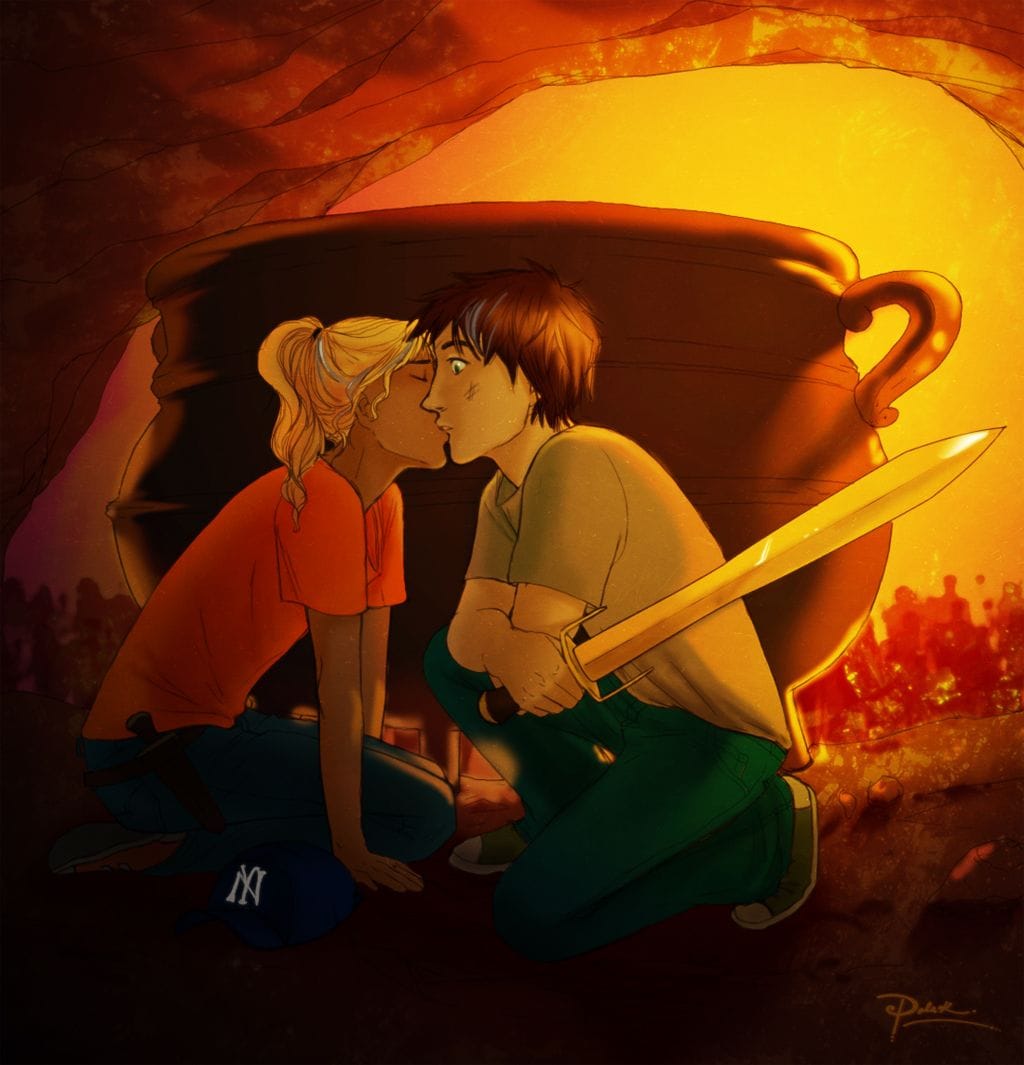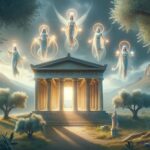The Telchines: enigmatic sea-daemons of Rhodes, masters of metallurgy, magic, and arguably malice, leaving an enduring mark on Greek mythology. Born of primordial forces, these shape-shifting beings are shrouded in conflicting narratives, reflecting their complex role in the cosmic order. Credited with forging iconic artifacts like Poseidon’s trident and Cronus’ scythe, the Telchines’ legacy is interwoven with the rise and fall of the Titans. Driven from Rhodes by divine wrath or natural disaster, their dispersal across the Aegean seeded myths and rituals from Crete to Cyprus. Let’s delve into the mysteries surrounding these fascinating figures.
Decoding the Telchines: Rhodes’ Magical Artisans
The Telchines were more than mythical rockstars; they were legendary artisans, sorcerers, and agricultural innovators, leaving their mark on the stories of gods and mortals. Their origins remain murky, much like trying to find the source of a hidden river. Let’s explore the depths of their world and uncover their unique attributes.
Origins: A Murky Beginning
The Telchines’ origin story is shrouded in mystery. Some ancient writers suggest they emerged from the primordial union of Pontus (the Sea) and Gaia (the Earth), a fitting connection given their affinity for the ocean. Other accounts link them to the darker pairing of Tartarus (the Underworld) and Nemesis (Retribution), hinting at a sinister side. Still others suggest they arose from the blood of Uranus (the Sky), proposing a celestial connection. This tapestry of possible origins adds to their mystique, portraying them as potent forces tied to the universe’s fundamental elements. It’s also possible that these varying accounts represent the evolution of myths across different regions and time periods.
More Than Metal: Masters of Craft and Magic
The Telchines were the go-to craftsmen for magical items and powerful weapons in ancient Greece. Legend suggests they forged Poseidon’s trident, the iconic symbol of his command over the waves. They are also credited with creating Kronos’s scythe, the formidable weapon used to overthrow Uranus. Their skills extended beyond metalworking, encompassing both beneficial and potentially destructive magic, making them a force to be reckoned with.
From Divine Servants to Dark Sorcerers: A Shifting Image
Early portrayals present the Telchines as divine ministers, even nurturing the young Poseidon. Imagine these part-fish, part-human beings caring for the future god of the sea! However, their image evolved, becoming increasingly associated with darker magic and destructive acts. Some narratives depict them as jealous and vengeful, cursing the land and inflicting blight upon crops. This transformation from divine helpers to something more sinister is a compelling aspect of their story, possibly reflecting changing cultural values and anxieties.
Enduring Legacy: The Telchines’ Impact
Despite their tarnished reputation, the Telchines’ influence on Greek mythology is undeniable. They’re interwoven into numerous significant myths, from nurturing powerful gods to creating weapons that shaped divine conflicts. Their strong ties to Rhodes suggest a significant role in local beliefs and traditions, perhaps even influencing the development of other regional myths. Did you know that Stateira was the wife of Artaxerxes II of Persia? This seemingly unrelated fact highlights the interconnectedness of ancient history and how seemingly disparate figures and events can be linked through broader cultural contexts.
Unveiling the Enigma: Hybridity, Duality, and Unresolved Questions
The Telchines continue to captivate scholars and mythology enthusiasts. Their aquatic connection and often-described fish-like features raise questions about the symbolic meaning of hybrid creatures in Greek mythology. What did it mean to be part human, part animal, and part divine? Their fluctuating reputation – from benevolent helpers to malevolent sorcerers – suggests a duality in their nature. What triggered this shift? Were they always capable of both good and evil, or did circumstances alter their path? Many questions remain unanswered, contributing to the enduring mystery of the Telchines. Further research may illuminate these enigmatic beings and their place within the intricate tapestry of Greek mythology. It’s likely that their story is even more complex than we currently understand, and ongoing research may uncover further layers of meaning.
What is a telkhine in Greek mythology?
Telkhines: those enigmatic figures lurking in the shadows of Greek myths, somewhere between god and mortal, their origins a puzzle. Some whisper of their birth from the blood of Uranus, the sky god; others from the essence of Sea and Earth. Their true nature remains obscured, like peering through murky ocean depths.
These magical sea spirits frequented the Greek islands – Rhodes, Crete, Cyprus – not for leisure, but as skilled craftsmen, forging legendary items such as Poseidon’s trident and the weapon Cronus wielded against Uranus.
Their shapeshifting abilities add to their mystique, transforming from human to dolphin, octopus, or any form they desired. This mutable nature begs the question: benevolent sea spirits or mischievous entities? Some tales depict them as guardians, teaching agriculture and nurturing Poseidon. Others reveal a jealous and spiteful side, wielding magic for destruction.
Their downfall remains an enigma. Did Zeus, Apollo, or Dionysus end their reign? Or were they victims of a natural disaster? The answer eludes us, leaving behind intriguing fragments of stories.
Key Points about Telkhines:
| Trait | Description |
|---|---|
| Origins | Mysterious; possibly from primordial forces, Uranus’s blood, or Pontus and Gaia. |
| Skills | Master craftsmen, magicians, capable of forging powerful artifacts. |
| Abilities | Shapeshifters, changing form at will. |
| Personality | Conflicting accounts: sometimes benevolent, sometimes malevolent. |
| Impact on Myths | Played a role in stories about gods and the creation of significant objects. |
Greek myths offer multiple versions, the telkhines’ story being no exception. Some experts believe this reflects the evolving nature of oral tradition; others suggest it represents diverse regional beliefs. Further research may unveil new clues, piecing together the fragmented puzzle. Remember, telkhines represent the mysteries and contradictions at the heart of Greek mythology.
What are telkhines in Percy Jackson?
In Rick Riordan’s Percy Jackson series, telkhines are a peculiar blend of dog, seal, and something else entirely – dog-headed, seal-bodied, with flippers morphing into feet. These magically gifted craftsmen forge powerful weapons for Titans and Olympian gods alike, seemingly driven by opportunity.
In Percy Jackson and the Battle of the Labyrinth, they toil beneath Mount Saint Helens, crafting weapons for the Titans. Later, in Percy Jackson and the Mark of Athena, they appear in the Georgia Aquarium, building with LEGOs. This unexpected setting suggests adaptability and perhaps playfulness, leaving their true motives unclear.
Drawn from Greek mythology, these original multi-talented magical artisans exhibit moral ambiguity, sometimes benevolent, sometimes malevolent. This complexity enriches their presence in the Percy Jackson series, transforming them from mere monsters into complex figures with a history, capable of creation and destruction.
Telkhines in Percy Jackson:
| Trait | Description |
|---|---|
| Appearance | Dog-faced, seal-bodied, flipper/feet – a unique look. |
| Abilities | Magical crafting, metallurgy, sorcery, possibly shape-shifting. |
| Allegiance | Flexible, working for Titans or gods based on opportunity. |
| Personality | Ambiguous, capable of both help and harm. |
| Notable Appearances | Percy Jackson and the Battle of the Labyrinth, Percy Jackson and the Mark of Athena |
Their LEGO-building in the aquarium raises questions. Are they crafting something powerful in disguise, or simply enjoying downtime? These unanswered questions make the telkhines and the Percy Jackson world compelling, hinting at a vaster mythological world with more to discover. In The Last Olympian, Percy even spares a Telekhine, demonstrating their potential for complex interactions with humans.
What do telkhines look like?
The telkhines, enigmatic figures from Greek mythology, possess a fluid description, varying across stories. Their appearance generally blends human and sea animal traits. Often depicted with the head of a dog or other sea creature, their webbed hands and feet, like seals or sea lions, emphasize their aquatic connection, lending an otherworldly quality.
Their origins are equally murky. Some accounts name Pontus and Gaia, the primordial deities of sea and earth, as their parents, while others suggest Tartarus and Nemesis, linking them to darker aspects of the universe. Another story claims their birth from the blood of Uranus. Still others say they were the children of Thalassa, the primal sea goddess, or even Poseidon. This lack of a definitive origin story contributes to their mystique and allows for diverse artistic interpretations.
Beyond their unusual appearance and mysterious origins, the telkhines are renowned for their skills. Master craftsmen, skilled sorcerers, and agricultural pioneers, they are credited with forging powerful artifacts like Poseidon’s trident and Cronus’s scythe.
Their portrayal shifts over time, from helpful divine beings to figures associated with black magic, jealousy, and curses. This change adds complexity. Were they always malevolent, or did something corrupt them?
As with many mythological figures, our understanding of the telkhines is constantly evolving. New discoveries and interpretations can illuminate old mysteries. While we can construct a probable image, there’s always room for new information. The telchines, with their shifting appearances and ambiguous nature, embody the ever-evolving aspect of ancient stories. They remain a captivating enigma.
- Unlock Filipino Culture: A Deep Dive into Traditions and Practices - April 23, 2025
- Unlock Spanish Culture: Insights & Opportunities Now - April 23, 2025
- White Spirit Uses & Substitutes: A Deep Dive for Pros & DIYers - April 23, 2025

















2 thoughts on “The Enigmatic Telchines: Exploring the Myth and Legacy of Rhodes’ Master Craftsmen”
Comments are closed.